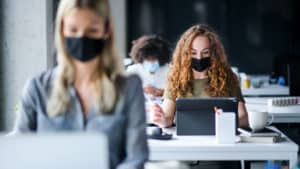Once the epicenter of the virus outbreak, the densely populated city of New York endured months of significantly high rates of confirmed infections and reported deaths. As cases began to steadily decrease in the month of May, Governor Cuomo’s daily televised briefs became cautiously more hopeful. As we march towards the official start of summer next week, Phase 2 of the state’s New York Forward Plan is expected to roll out in the Big Apple by month’s end – completed benchmarks withstanding. Outdoor dining, barbershops & salons, and in-store retail shops will be allowed to open. The city that suffered an undeniable loss in the early months of 2020 is about to regain some normalcy in everyday life. But what IS the new normal in the US? Depending on where you live – and where you work – it could mean very different things.
CDC and OSHA Guidelines Create the Framework for COVID-19 Policies

Executive Orders in states like Minnesota and Michigan require businesses to develop “COVID-19 Preparedness and Response Plans” that strictly adhere to state and OSHA guidelines, while states like Tennessee encourage businesses to just add a line item or addendum to their “Employee Sickness Policy” specific for COVID-19. The CDC recently added to their COVID-19 recommendations for office spaces with advice ranging from staggering shift, start, and break times to protective shields to separate employees.
As straight-forward as CDC guidelines, Executive State Orders, and local policies aim to be, business leaders are often left uncertain on the most effective plan for their own operations. The American workforce is emerging from a dismal spring spent in quarantine, and the reality of a new workplace environment is setting in. The dual burden and responsibility for business leaders to ensure staff is safe and protected while maintaining positive revenue streams is an unprecedented challenge. Due to the tenuous nature of the virus, an increase in reinfection rates is all but guaranteed during the fall/winter season requiring an organization’s COVID-19 policy to retain sufficient flexibility for more outbreaks.
In a May 5th article from the Wall Street Journal, VIGILINT Founder and Chief Medical Officer Eric Ossmann, M.D., discussed risk mitigation strategies for enterprise businesses’ return-to-work programs. Interpublic Group, a long-standing client of VIGILINT, is considering separating their 22,000 employees into three health risk categories where age and medical history would be determinants. Ossmann advised Interpublic on this solution stating: “It is a reasonable approach, if you get through the operational and some of the privacy and regulatory issues.” Employee compliance is a key factor in making a policy like the one Interpublic Group is considering work, and practical human realities need to be considered. As an alternative for on-site screenings at worksites, VIGILINT has consulted major corporations to implement at-home screening protocols for employees and self-administered RT-PCR tests prescribed by a VIGILINT physician when screening results are positive for COVID-19. Individuals would mitigate the risk of community spread with at-home screening procedures.
Back in New York City, Goldman Sachs announced that they will turn anyone away with a 100.4° temperature or higher when they open the doors to their headquarters at the end of the month. For other major companies in Manhattan, savvy temperature sensors and touch-free elevators could be normalized by next year.
COVID-19 Customized Consulting and Policy Development
The unique business operations of an organization should determine which guidelines to consider and implement for an effective and streamlined program. VIGILINT works with clients to understand the business’ capabilities and care-abouts for a successful COVID-19 plan, and provides the necessary medical direction and oversight. As cities like New York ease restrictions for everyday life and for businesses, it will be critical for organizations to monitor COVID-19 trends and according to Dr. Sean Siler VIGILINT CEO “assuage [employee’s] fears when reopening workplaces.”
